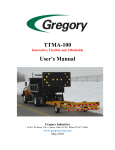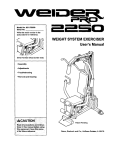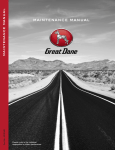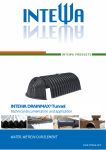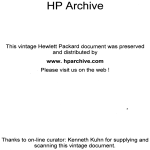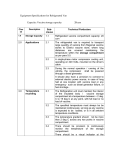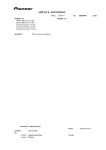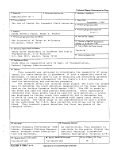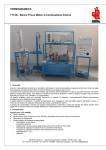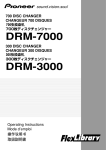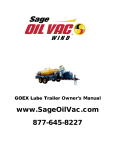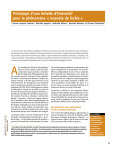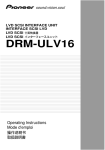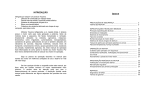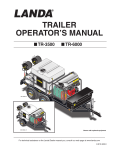Download USER`S MANUAL - GSI Highway Products
Transcript
TTMA-100 User’s Manual Safety Trailers, Inc. 9 Cotswold Lane San Antonio, TX 78257 (210) 464-3465 www.safetytrailers.com September 2007 FOREWORD Thank you for your purchase of the Trailer Truck Mounted Attenuator, Model 100, from Safety Trailers, Inc. (herein referred to as the TTMA-100). The TTMA-100 is a Test Level 3 (TL-3) crash cushion designed for use with a support truck in both stationary and moving work zones. We are committed to providing our customers with highway safety products that have the best performance and value for your money, as well as the highest level of customer service. The TTMA-100 is one of the most innovative TMA’s in the market, offering a higher level of performance with heavy tow vehicles and requiring no modification of the tow vehicle. It has successfully passed all required and optional crash tests set forth in NCHRP Report 350 and is fully approved for use on the National Highway System by the Federal Highway Administration. This manual has been written to help you with the operation and maintenance of the TTMA-100. Please read and understand the recommendations contained in this manual thoroughly before use, and keep it handy for future reference. If you have any questions or comments regarding the operation and maintenance of this product, please do not hesitate to contact us by telephone at (210)-464-3465, e-mail at [email protected], or conventional mail at 9 Cotswold Lane, San Antonio, TX 78257. This manual is divided into five sections: • TTMA Design and Major Components. An overview of the Trailer TMA design and major components are presented in this section, including the product specifications and parts list. • Assembly Guidelines. Directions on the assembly of the TTMA-100 are outlined and illustrated in this section. • Operation Guidelines. Guidelines pertaining to the operation of the Trailer TMA are presented in this section, such as minimum support truck weight, roll-ahead distances, connections, and other operational items. • Maintenance Guidelines. Considerations on the routine maintenance of the Trailer TMA are outlined in this section. • Repair of Damaged Trailer. Discussion of impacts by an errant vehicle and the associated repair and replacement of trailer parts are presented in this section. ii CUSTOMER SERVICE CONTACTS Safety Trailers, Inc. is committed to providing the best service and care to our customers. You are automatically registered with your purchase and you will be notified of any future changes or upgrades to the TTMA-100. If you have any comments or questions regarding this product, please contact STI via telephone, e-mail or conventional mail: Telephone: (210)-464-3465; Monday to Friday, 9:00 a.m. to 5:00 p.m. Central Time. Fax: (210) 698-0556 Email: [email protected] Web Site: http://www.safetytrailers.com Mail: Safety Trailers, Inc. 9 Cotswold Lane San Antonio, TX 78257. iii TABLE OF CONTENTS Page FOREWORD . . . . . . . . . . . . . . . . . . . . . . . . . . . . . . . . . . . . . . . . . . . . . . . . . . . . . . . . ii CUSTOMER SERVICE CONTACTS . . . . . . . . . . . . . . . . . . . . . . . . . . . . . . . . . . . . iii TTMA-100 DESIGN AND MAJOR COMPONENTS . . . . . . . . . . . . . . . . . . . . . . . . General . . . . . . . . . . . . . . . . . . . . . . . . . . . . . . . . . . . . . . . . . . . . . . . . . . . . . . . Figure 1. Schematic and Parts Layout of TTMA-100 . . . . . . . . . . . . . . . . . . Table 1. General Specifications . . . . . . . . . . . . . . . . . . . . . . . . . . . . . . . . . . Table 2. Trailer Component and Parts List . . . . . . . . . . . . . . . . . . . . . . . . . . Figure 2. TTMA-100 Wiring and Light Layout . . . . . . . . . . . . . . . . . . . . . . Wiring Instructions . . . . . . . . . . . . . . . . . . . . . . . . . . . . . . . . . . . . . . . . . . . . . . 1 1 2 3 4 5 6 INSTALLATION GUIDELINES . . . . . . . . . . . . . . . . . . . . . . . . . . . . . . . . . . . . . . . . Shipping Package . . . . . . . . . . . . . . . . . . . . . . . . . . . . . . . . . . . . . . . . . . . . . . . Recommended Tool List . . . . . . . . . . . . . . . . . . . . . . . . . . . . . . . . . . . . . . . . . Bolt Torque Specifications . . . . . . . . . . . . . . . . . . . . . . . . . . . . . . . . . . . . . . . . Pintle Hook . . . . . . . . . . . . . . . . . . . . . . . . . . . . . . . . . . . . . . . . . . . . . . . . . . . . 8 8 8 8 9 OPERATION GUIDELINES. . . . . . . . . . . . . . . . . . . . . . . . . . . . . . . . . . . . . . . . . . . . Minimum Weight of Tow Vehicle . . . . . . . . . . . . . . . . . . . . . . . . . . . . . . . . . . Tow Vehicle Roll Ahead Distances . . . . . . . . . . . . . . . . . . . . . . . . . . . . . . . . . Table 3. Calculated Roll Ahead Distances for Shadow Vehicles . . . . . . . . . . Table 4. Calculated Roll Ahead Distances for Barrier Vehicles . . . . . . . . . . Attachment of TTMA-100 to Tow Vehicle . . . . . . . . . . . . . . . . . . . . . . . . . . . Operation of TTMA-100 . . . . . . . . . . . . . . . . . . . . . . . . . . . . . . . . . . . . . . . . . 10 10 10 12 13 14 14 MAINTENANCE GUIDELINES . . . . . . . . . . . . . . . . . . . . . . . . . . . . . . . . . . . . . . . . 16 REPAIR GUIDELINES . . . . . . . . . . . . . . . . . . . . . . . . . . . . . . . . . . . . . . . . . . . . . . . Impact by Errant Vehicle . . . . . . . . . . . . . . . . . . . . . . . . . . . . . . . . . . . . . . . . . TTMA-100 Repair . . . . . . . . . . . . . . . . . . . . . . . . . . . . . . . . . . . . . . . . . . . . . . Damage Assessment and Repair Parts Packages . . . . . . . . . . . . . . . . . . . . . . . No Apparent Damage to Trailer . . . . . . . . . . . . . . . . . . . . . . . . . . . . . . . . Axle Assembly Not Detached . . . . . . . . . . . . . . . . . . . . . . . . . . . . . . . . . Axle Assembly Detached, but No Damage to Trailer A-Frame . . . . . . . . Bursting Reaches Trailer A-Frame . . . . . . . . . . . . . . . . . . . . . . . . . . . . . . Technical Assistance . . . . . . . . . . . . . . . . . . . . . . . . . . . . . . . . . . . . . . . . . 17 17 19 19 20 20 21 22 22 iv TTMA-100 DESIGN AND MAJOR COMPONENTS GENERAL A schematic of the TTMA-100 is shown in Figure 1. The major components of the TTMA-100, as shown in Figure 1, are as follows: Component A B C D E F G H J K Description Impact Head Bursting Mandrel First Energy Absorbing Tube Trailer Frame Axle Assembly Plastic Guide Plates End Caps Hitch Assembly Spacer Jack Assembly Table 1 presents the general specifications for the Trailer TMA, including: • • • • Overall dimensions, i.e., length, width and maximum height to the top of the impact head and the top of the light bar Weight of the trailer with no optional equipment and the tongue weight. Note the small tongue weight of the trailer, which would not affect the load carrying capacity of the tow vehicle. The capacity and mounting height of the pintle hook. Information on the axle assembly, i.e., load rating, wheel and tire sizes, and cold inflation pressure. Table 2 provides a list of parts with legends and part numbers. Please refer to these part numbers and legends for ordering of spare parts. Note that this is not a complete parts list. Please inquire about the complete parts list and pricing from the manufacturer, distributor, or reseller of the Trailer TMA. Figure 2 shows the schematic of the wiring details of the Trailer TMA. Also, detailed instructions on the wiring of the trailer TMA are provided in a separate Wiring Manual and will not be repeated herein. However, the trailer TMA is fully wired at the time of delivery. The only item that may require attention of the user is the wiring of the trailer plug for connection to the tow vehicle. More detailed instructions on are provided later in this section. 1 2 TABLE 1. GENERAL SPECIFICATIONS Overall Dimensions: Length Width Maximum Height (to top of impact head) Maximum Height (to top of light bar) Weight: Basic Trailer Weight with No Optional Equipment Approximate Tongue Weight Pintle Hook: Capacity Rating (Minimum) Mounting Height 23 ft 8 ft 2 ft 3 ft 6 in. 0 in. 7 in. 1 in. 1,450 lb 150 lb 7200 mm 2440 mm 788 mm 940 mm 660 kg 68 kg 8 tons 7250 kg 19.5-32.0 in. 500-800 mm Breakaway Axle: Rating Tire Size Rim Size Cold Tire Inflation Pressure 1,750 lb 205/75D15 15x5JJ 30 psi 3 795 kg 205/75D15 15x5JJ 210 Kpa TABLE 2. TRAILER COMPONENT AND PARTS LIST TRAILER COMPONENTS ITEM PART # QUANTITY DESCRIPTION A T100A 1 Impact Head B T100B 2 Bursting Mandrel C T100C 2 First Stage Energy Absorber D T100D 1 Trailer A-Frame E T100E 1 Axle Assembly F T100F 4 Plastic Guide Plates G T100G 2 End Caps H T100H 1 Hitch Assembly J T100J 8 Spacer K T100K 1 Jack Assembly HARDWARE ITEMS ITEM PART# QUANTITY DESCRIPTION a B0516070A 6 5/16” x 7” Grade 5 Hex Bolt b W0516 6 5/16” Washer c LW0516A 6 5/16” Heavy Lock Washer d N0516A 6 5/16” Grade 5 Hex Nut e B0816020A 8 1/2” x 2” Grade 5 Hex Bolt f W0816 8 1/2” Washer g LW0816A 12 1/2” Heavy Lock Washer h N0816A 12 1/2” Grade 5 Hex Nut j B0916030A 16 9/16” x 3” Grade 5 Hex Bolt k W0916S 16 9/16” SAE Washer m LW0916A 16 9/16” Heavy Lock Washer n N0916A 16 9/16” Grade 5 Hex Nut o B1016025A 4 5/8” x 2 1/2” Grade 5 Hex Bolt p W1016 4 5/8” Washer q LW1016A 4 5/8” Heavy Lock Washer r N1016A 4 5/8” Grade 5 Hex Nut 4 5 WIRING INSTRUCTIONS As mentioned previously, the only item that may require attention of the user is the wiring of the trailer plug for connection to the tow vehicle. There are two distinctly different wire plugs that are not compatible, one is the RV plug and the other is the heavy duty truck plug. It is necessary to first determine which type of plug is used with the tow vehicle, i.e., an RV plug or a heavy duty truck plug. The shapes of the two plug types are easier distinguishable as shown in the following photographs. Also, the RV plug uses blades and the truck plug uses round pins. Note that the wiring scheme for the two plug types are totally different, details of which are shown in the following tables. RV Plug Heavy Duty Truck Plug Standard Wiring For RV Plugs With Separate Brake Wire Plug Labels Function Common Ground Brake light Tail/Marker lights 12V Power supply Left Turn Right Turn Auxiliary Trailer Wire Color White Red Brown Blue Yellow Green Black Number 1 2 3 4 5 6 7 6 Color White Blue Green Black Red Brown (center) Standard Wiring For Heavy Duty Truck Plugs Plug Labels Function Common Ground Auxiliary Left Turn Brake light Right Turn Tail/Marker lights 12V Power supply Trailer Wire Color White Black Yellow Red Green Brown Blue Number 1 2 3 4 5 6 7 Color White Black Yellow Red Green Brown Blue Note that the above wiring patterns represent standard wiring for the tow vehicle. The above pattern may need to be adjusted if the tow vehicle does not use standard wiring. 7 INSTALLATION INSTRUCTIONS SHIPPING PACKAGE This manual is intended for the operation and maintenance of the TTMA-100. If you ordered and received the unit in a partially assembled state, please refer to the accompanying Assembly Manual for detailed instructions. If you have any questions in this regard, please contact STI Customer Services prior to utilizing the trailer. RECOMMENDED TOOL LIST The following is the recommended tool list for assembling the TTMA-100: • • • • • • • • • Socket wrenches: ½”, ¾”, 13/16”, 15/16” Open end wrenches: ½”, ¾”, 13/16”, 15/16” Pneumatic wrench Drift pin Wire crimper Round and flat metal files Electric drill and bits 4-ft level Measuring tape Optional: • Fork lift/crane for parts manipulation. Note that some parts are very heavy and care should be taken in assembling and disassembling the unit. BOLT TORQUE SPECIFICATIONS All bolts should be tightened to the specified torque prior to use of the Trailer TMA. The following are the recommended torques to the bolts according to the bolt size: Bolt Size (in) 5/16” 1/2” 9/16” 5/8” Torque (ft-lb) 15 60 85 115 Torque (N-m) 20 81 115 156 8 PINTLE HOOK The pintle hook should have a minimum capacity rating of 8 tons (7,250 kilograms). Due to the wide variations in the frame structures of different tow vehicles, there is not a single standard means of mounting the pintle hook assembly to the frame of the tow vehicle. The major considerations in mounting of the pintle hook are the strength of the attachment and the mounting height. The pintle hook assembly may be welded or bolted to the frame of the tow vehicle. Regardless of the method of mounting or attachment to the tow vehicle, it is critical to ensure that the strength of the attachment exceeds the rated capacity of the pintle hook with a wide margin of safety. It is the obligation of the users to ensure that their particular pintle hook attachment system meets these strength requirements. There are two mounting positions for the lunette ring. The nominal height of the upper mounting position is 28 inches (710 mm) and the nominal height for the lower position is 23.5 inches (600 mm). The TTMA-100 can accommodate a variation of up to 4 inches (100 mm) from the nominal height. Hence, when the lunette ring is in the upper position, the TTMA-100 can be attached to a pintle hitch ranging from a minimum of 24 in. (610 mm) to a maximum of 32 in. (810 mm) in height. When the lunette ring is in the lower position, the TTMA-100 can be mounted on pintle hooks ranging from a minimum of 19.5 in. (495 mm) to a maximum of 27.5 in. (699 mm) in height. 9 OPERATION GUIDELINES MINIMUM WEIGHT OF TOW VEHICLE The minimum recommended weight for the tow vehicle is 10,000 lb (4,536 kg) gross vehicle weight (GVW). There is no specified maximum weight for the tow vehicle. All TTMA-100 crash tests, including the required and optional crash tests specified under NCHRP Report 350, were conducted with the Trailer TMA attached to a tow vehicle that was blocked against any forward movement. In other words, the trailer can be attached to any support truck weighing more than 10,000 lb (4,536 kg), even a truck weighing as much as 100,000 lb (45,360 kg) or more. TOW VEHICLE ROLL AHEAD DISTANCES One of the major safety considerations is the roll ahead distance of the shadow vehicle when impacted by an errant vehicle. When the tow vehicle with a TTMA-100 attached is impacted by an errant vehicle, it will move forward. It is therefore important to allow sufficient space between the tow vehicle and the workers so that the roll ahead of the tow vehicle would not pose a safety concern for the workers. Tables 3 and 4 show the expected roll ahead distances for rolling and stationary tow vehicles, respectively, as a function of impact speed and weights of the support truck and impacting vehicle. The space between the support vehicle and the workers should exceed the roll ahead distance under the prevailing operating conditions. The roll ahead calculations shown in Table 3 and 4 are based upon procedures presented in “Guidelines for the Use of Truck-Mounted Attenuators in Work Zones,” by Jack B. Humphries and T. Darcy Sullivan, TRR No. 1304, 1991, 292-302. Please follow the following steps to determine the appropriate roll ahead distance: 1. Assess the nature of the operation (i.e., moving or stationary operation). In a moving operation, the tow vehicle is moving at slow speed, such as 10 to 20 mph (16 to 32 km/h). In a stationery operation, the shadow vehicle is stopped with the parking brakes on. Use Table 3 for moving operations and Table 4 for stationary operations. 2. Select the weight that best approximates the actual weight of the tow vehicle: 10,000, 15,000, 24,000, 40,000, 60,000 or 80,000 lb (4,535, 6,800, 10,900, 18,000, 27,000, or 36,000 kg). Note that the weight of the support truck should include the weights of items to be carried on the truck during the operation and the weight of the TTMA-100. 3. Select the range of prevailing speed of the traffic at the work zone: 45, 55 or 65 mph (72, 88 or 104 km/h). 10 4. Select the weight of the impact vehicle to be contained: 10,000, 15,000, or 24,000 lb (4,536, 6,800, or 10,900 kg). 5. Select from the appropriate table the expected roll ahead distance For example: If you are operating a tow vehicle with a gross weight of 15,000 lbs. (6,800 kg) as a stopped shadow vehicle in an area where the operating traffic speed is 45 mph (72 km/h), and there are few if any large trucks in the mix of traffic. You would start with Table 4, select the appropriate values from above, and determine that the maximum roll ahead distance would be 11’ (3.4m). This is the distance from the front of the tow vehicle to the work area that should be provided. 11 Table 3. Calculated Roll Ahead Distances for Moving Operation Tow Vehicle Weight, lb (kg) 10000 (4,550) 15000 (6,800) 24000 (10,900) 40000 (18,200) 60000 (27,250) 80000 (36,400) Traffic Operating Speed, mph (km/h) 4500 (2,050) 10000 (4,550) 15000 (6,800) 24000 (10,900) 65 (105) 119’ (36.3 m) 205’ (62.5 m) 261’ (79.6 m) 333’ (102 m) 55 (89) 97’ (29.6 m) 158’ (48.2 m) 198’ (60.4 m) 247’ (75.3 m) 45 (72) 77’ (23.5 m) 118’ (36.0 m) 143’ (43.6 m) 174’ (53.0 m) 65 (105) 93’ (28.3 m) 161’ (49.1 m) 211’ (64.3 m) 278’ (84.7 m) 55 (89) 78’ (23.8 m) 127’ (38.7 m) 162’ (49.4 m) 209’ (63.7 m) 45 (72) 65’ (19.8 m) 97’ (29.6 m) 120’ (36.6 m) 150’ (45.7 m) 65 (105) 71’ (21.6 m) 118’ (36.0 m) 157’ (47.9 m) 215’ (65.5 m) 55 (89) 62’ (18.9 m) 97’ (29.6 m) 124’ (37.8 m) 165’ (50.3 m) 45 (72) 54’ (16.5 m) 77’ (23.5 m) 96’ (29.3 m) 122’ (37.2 m) 65 (105) 56’ (17.1 m) 86’ (26.2 m) 112’ (34.1 m) 155’ 47.2 m) 55 (89) 50’ (15.2 m) 73’ (22.3 m) 92’ (28.0 m) 123’ (37.5 m) 45 (72) 45’ (13.7 m) 61’ (18.6 m) 74’ (22.6 m) 95’ (29.0 m) 65 (105) 48’ (14.6 m) 68’ (20.7 m) 86’ (26.2 m) 118’ (36.0 m) 55 (89) 44’ (13.4 m) 60’ (18.3 m) 73’ (22.3 m) 96’ (29.3 m) 45 (72) 41’ (12.5 m) 52’ (15.8 m) 61’ (18.6 m) 77’ (23.5 m) 65 (105) 44’ (13.4 m) 59’ (18.0 m) 73’ (22.3 m) 97’ (29.6 m) 55 (89) 41’ (12.5 m) 53’ (16.2 m) 63’ (19.2 m) 81’ (24.7 m) 45 (72) 39’ (11.9 m) 47’ (14.3 m) 54’ (16.5 m) 67’ (20.4 m) Impact Vehicle Weight, lb (kg) 12 Table 4. Calculated Roll Ahead Distances for Stationary Operation Tow Vehicle Weight, lb (kg) 10000 (4,550) 15000 (6,800) 24000 (10,900) 40000 (18,200) 60000 (27,250) 80000 (36,400) Traffic Operating Speed, mph (km/h) 4500 (2,050) 10000 (4,550) 15000 (6,800) 24000 (10,900) 65 (105) 38’ (11.6 m) 103’ (31.4 m) 152’ (46.3 m) 216’ (65.8 m) 55 (89) 27’ (8.2 m) 74’ (22.6 m) 109’ (33.2 m) 155’ (47.2 m) 45 (72) 18’ (5.5 m) 50’ (15.2 m) 73’ (22.3 m) 104’ (31.7 m) 65 (105) 22’ (6.7 m) 68’ (20.7 m) 108’ (32.9 m) 166’ (50.6 m) 55 (89) 16’ (4.9 m) 49’ (14.9 m) 77’ (23.5 m) 119’ (36.3 m) 45 (72) 11’ (3.4 m) 33’ (10.1 m) 52’ (15.8 m) 80’ (24.4 m) 65 (105) 11’ (3.4 m) 38’ (11.6 m) 65’ (19.8 m) 111’ (33.8 m) 55 (89) 8’ (2.4 m) 27’ (8.2 m) 47’ (14.3 m) 80’ (24.4 m) 45 (72) 6’ (1.8 m) 18’ (5.5 m) 32’ (9.8 m) 54’ (16.5 m) 65 (105) 5’ (1.5 m) 18’ (5.5 m) 34’ (10.4 m) 64’ (19.5 m) 55 (89) 4’ (1.2 m) 13’ (4.0 m) 24’ (7.0 m) 46’ (14.0 m) 45 (72) 3’ (0.9 m) 9’ (2.7 m) 16’ (4.9 m) 31’ (9.4 m) 65 (105) 3’ (0.9 m) 10’ (3.0 m) 19’ (5.8 m) 38’ (11.6 m) 55 (89) 2’ (0.6 m) 7’ (2.1 m) 13’ (4.0 m) 27’ (8.2 m) 45 (72) 2’ (0.6 m) 5’ (1.5 m) 9’ (2.7 m) 18’ (5.5 m) 65 (105) 2’ (0.6 m) 6’ (1.8 m) 12’ (3.7 m) 25’ (7.6 m) 55 (89) 1’ (0.3 m) 5’ (1.5 m) 9’ (2.7 m) 18’ (5.5 m) 45 (72) 1’ (0.3 m) 3’ (0.9 m) 6’ (1.8 m) 12’ (3.7 m) Impact Vehicle Weight, lb (kg) 13 ATTACHMENT OF TTMA-100 TO TOW VEHICLE The TTMA-100 is attached to the tow vehicle via the pintle hook with a minimum capacity of 8 tons. Warning! Verify that the retaining pin for the pintle hook is properly locked to avoid accidental release of the pintle hook and the TTMA-100. Warning! Make sure that the trailer lights are connected to the tow vehicle and are operating properly. Warning! Ensure that the safety chains properly secure the TTMA-100 to the tow vehicle. OPERATION OF TTMA-100 Operation of the Trailer TMA is similar to that of other trailers. Special attention should be given to the following issues: Warning! The TTMA-100 device does not have brakes. All braking will be dependent on the tow vehicle. Thus, additional distance should be allowed for in braking and stopping of the tow vehicle. Warning! Do not use the Trailer TMA for hauling. Objects on the trailer would be a hazard for vehicles impacting the TTMA-100. Warning! Attachment of the trailer TMA results in wider turns. Drivers should be aware of this need for wider turning radius and adjust their driving accordingly. Warning! Attachment of any trailer TMA will result in different handling for the tow vehicle while backing up. Drivers should be aware of this difference in vehicle handling characteristics and adjust their driving accordingly. Warning! Tow vehicles should be equipped with head rests, lap belts and shoulder straps to provide proper crash protection for the driver and passengers. Operators should adjust their head rest to contact the center of the head and should wear seat belt and shoulder strap at all times. Warning! Do not attach any item to the trailer or hitch without explicit approval from the manufacturer. Contact STI Technical Support or Customer Service for any question regarding attachments to the trailer ([email protected], Phone: 210-464-3465). 14 This manual does not cover the operation of optional equipment such as arrow boards, variable message sign boards, and other approved hitch mounted equipment. Please see appropriate operating manuals accompanying those devices for instructions. 15 MAINTENANCE GUIDELINES Proper maintenance of the TTMA-100 is critical to assure continuing safe operation and long-term durability of the device. Even though the unit is galvanized, the outside of the TTMA-100 should be washed periodically, particularly during winter usage, to eliminate salt and other road contaminants. The inside of the frame should also be washed annually. The end caps (Item G) can be removed to allow rinsing the inside of the frame. Care should be taken with the wiring for the side marker lights during this process. Note that all critical parts of the TTMA-100 are hot-dip galvanized, thus require minimal maintenance. The following preventive maintenance schedule is recommended: 3 Months/ or 3,000 Miles 12 Months or 12,000 Miles Item Function Required Before Each Use Lighting System Test that all lights are operational ●● Pintle Hook Check capacity and verify that the retaining pin is properly inserted ●● Safety Chains Check that they are properly attached ●● Tire Inflation Set to 30 psi Tire Condition Inspect for cuts, wear, bulging, etc… ●● Wheels Inspect for cracks, dents, distortion or other signs of wear ●● Bolts and Wheel Nuts Tighten to manufacturer specified torque values ●● Wheel Bearings and Cups Inspect for corrosion or wear. Clean and repack ●● Frame Welds Check for cracks, call STI for instruction if cracks are detected. ●● Weekly ●● 16 REPAIR OF DAMAGED TRAILER Impact by Errant Vehicle The TTMA-100 is designed to reduce the impact severity for both the occupants of the impacting vehicle and the tow vehicle by dissipating the impact energy in a gradual and controlled manner. When the TTMA-100 is impacted by an errant vehicle, the following sequence of events will occur (all references to parts are depicted in Figure 1 and described in Table 2): 1. For impacts of 5 mph (8 km/h) or less, which are generally termed as nuisance hits, results from crash testing have shown that there is typically no damage to the energy absorption assembly of the TTMA-100. 2. For higher speed impacts, the shear bolts holding the mandrels (Part a) to the energy absorbing tubes will be sheared off, thus releasing the mandrels to move forward. 3. The mandrels (Part B) are pushed forward by the impacting vehicle and engage the ends of the energy absorbing tubes (Part C). 4. As the mandrels are pushed forward, bursting of the energy absorbing tubes into four strips of metal is initiated as shown in the photograph, thereby dissipating the energy from the impacting vehicle. 17 5. The sequence of events from here on depends on the speed and weight of the impacting vehicle. Low-speed impact: a. The impacting vehicle comes to a complete stop prior to the mandrels (Part B) reaching the breakaway axle (Part E) Medium-speed impact: a. The mandrels (Part B) reach the breakaway axle and shear off the bolts connecting the axle assembly to the energy absorbing tube, thus releasing the axle. b. The impact head (Part A) contacts the axle push rods and move the axle forward as the bursting process continues. e. The impacting vehicle comes to a complete stop prior to the mandrels reaching the splice connecting the energy absorbing tubes and the trailer frame (Part D). High-speed impact: a. The mandrels (Part B) continue past the splice connecting the energy absorbing tubes (Part C) and the trailer frame (Part D). The vehicle is eventually brought to a safe stop against the impact head or disengages from the impact head and spins out prior coming to a complete stop. 18 TTMA-100 REPAIR For impacts requiring repair and replacement of parts on the TTMA-100, Safety Trailers, Inc. offers different parts packages depending on the extent of damage sustained by the unit. These parts packages come with specific instructions regarding repair of your damaged trailer. These parts packages are available through STI or a designated distributor in your area. FOR A LIMITED TIME, REPLACEMENT PARTS ARE AVAILABLE AT MANUFACTURER COST PLUS HANDLING COSTS IN EXCHANGE FOR DOCUMENTATION OF THE IMPACTS AND/OR ACCIDENTS. To facilitate our evaluation of the in-service performance of the TTMA-100, we offer, for a limited time, repair parts packages at manufacturing cost plus 10 percent FOB Indiana, if complete records of the incident are forwarded to STI within 30 days of the occurrence. These records include a completed STI incident report (available on our web site www.safetytrailers.com or by calling 210-464-3465) and one or more of the following items: photographs of damaged trailer, photographs of the impacting and tow vehicles, police accident report if available, and phone interviews with involved parties. These parts packages are also available for purchase by the end user to be kept in stock. In this case, STI will issue rebates if the incident requiring replacement of the parts is reported to STI as described above. DAMAGE ASSESSMENT AND REPAIR PARTS PACKAGES Inspect the trailer TMA to assess the extent of the damage and the necessary repairs. Due to the simple design of the TTMA-100, damages to the trailers are usually very evident. Nevertheless, the trailer should be thoroughly inspected to assure that it is in proper working order prior to returning the trailer into service. The extent of damage to the trailer will vary greatly, depending on the nature and severity of the impact. It would not possible to cover all situations that could potentially be encountered in real-world crashes. Thus, the instructions are presented in general terms for the following levels of damage to the trailer. • • • • No apparent damage to trailer. Energy absorbing tubes (Part C) bursted, but axle assembly (Part E) not detached. Energy absorbing tubes (Part C) bursted and axle assembly (Part E) detached, but the bursting does not reach the trailer A-frame (Part D). Bursting reaches trailer A-frame. Detailed discussions on the required repair and replacement parts for each level of damage are presented as follows. 19 No Apparent Damage to Trailer • Inspect shear bolts (Part a) holding mandrels (Part B) in place with the energy absorbing tubes (Part C). If the shear bolts are bent or broken, replace the bolts. • Inspect trailer lighting system for damage. If the lighting system sustains only minor damage, such as a broken lens or light bulb, repair the damaged items, which may be readily purchased from automotive supplies stores. Make sure that all the lights are working properly prior to returning the trailer to service. Order the appropriate parts in accordance with the damage sustained by the trailer. Part No. NHRC Items in Package Shear bolts, nuts, washers and plastic guide plates. Axle Assembly not Detached • Replace energy absorbing tubes (Part C) and shear bolts (Parts a, b, c, d). • Inspect trailer lights for damage. If the lighting system sustains only minor damage, such as a broken lens or light bulb, repair the damaged items, which may be readily purchased from automotive supplies stores. Make sure that all the lights are working properly prior to returning the trailer to service. If the lighting system is severely damaged and no longer functional, replace the entire lighting system. • Inspect impact head (Part A) and mandrels (Parts B) for damage. For this severity of impact, it is unusual for either the impact head or the mandrels to be damaged to the extent that they are no longer usable and needs to be replaced. Nonetheless, check to make sure that the impact head and mandrels are not severely bent and are properly aligned with the energy absorbing tubes. • Inspect lunette ring and pintle hook for damage. For this severity of impact, it is unusual for either the lunette ring or the pintle hook to be damaged to the extent that they are no longer usable and needs to be replaced. Nonetheless, check to make sure that the lunette ring and the pintle hook are not severely bent and can be hooked up properly. 20 Order the appropriate parts in accordance with the damage sustained by the trailer. Part No. LSRC T100-LB Items in Package 2 each (Parts C, a, b, c, d, g, and h) Basic light system Axle Assembly Detached, but No Damage to Trailer A-Frame. • Replace energy absorbing tubes (Part C) and shear bolts (Parts a, b, c, d, g and h). • Inspect the breakaway axle assembly (Part E) for damage. Replace axle if visibly bent. If the axle is not damaged, but the push rods are bent, straighten out the push rods. Make sure that the push rods are attached to the axle properly. If the axle is not damaged, but the fenders are severely bent, replace only the fenders. • Inspect trailer lights for damage. If the lighting system sustains only minor damage, such as a broken lens or light bulb, repair the damaged items, which may be readily purchased from automotive supplies stores. Make sure that all the lights are working properly prior to returning the trailer to service. If the lighting system is severely damaged and no longer functional, replace the entire lighting system. • Inspect impact head (Part A) and mandrels (Parts B) for damage. For this severity of impact, it is unusual for either the impact head or the mandrels to be damaged to the extent that they are no longer usable and needs to be replaced. Nonetheless, check to make sure that the impact head and mandrels are not severely bent and are properly aligned with the energy absorbing tubes. • Inspect lunette ring and pintle hook for damage. For this severity of impact, it is unusual for either the lunette ring or the pintle hook to be damaged to the extent that they are no longer usable and needs to be replaced. Nonetheless, check to make sure that the lunette ring and the pintle hook are not severely bent and can be hooked up properly. Order the appropriate parts in accordance with the damage sustained by the trailer. 21 Part No. LSRC T100-AA Items in Package 2 each (Parts C, a, b, c, d, g, and h) Axle Assembly (Part E) T100EF Fenders (2) T100-LB Basic lighting system Bursting Reaches Trailer A-Frame For this high severity of impact, it is not advisable to repair the trailer. It is recommended that the user should consider purchasing a new trailer. First, the cost for the replacement parts would approach that of a new trailer. Second, extensive assembly would be required, which may pose some problems for someone not familiar with the details of the trailer. Technical Assistance If you have any questions regarding these inspections and assessment of damage to the trailer or required repair parts, please contact STI Technical Help by telephone at (210)464-3465, e-mail at [email protected], or conventional mail at 9 Cotswold Lane, San Antonio, TX 78257. In order for STI Technical Assistance to better provide assessment of the trailer or required repair parts, it would be most helpful if you can send photographs of the damaged trailer, both showing the overall damages and damages to the specific areas or parts in question. . 22


























